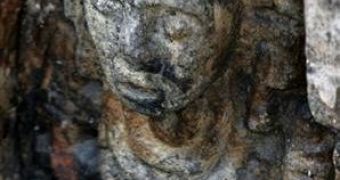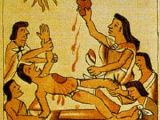A team of Mexican archaeologists led by ?lvaro Barrera have uncovered in the center of Mexico City an altar and a 11 foot (3.5 m) monolith that date back more than 500 years.
The discoveries were made at the Aztec empire's main temple, Templo Mayor (Great Temple), near the central Zocalo square. This is the most important Aztec find since the discovery of an eight-ton carving of an Aztec goddess at the same site in 1978. "This is a really impressive and exceptional Aztec monolith," said Leonardo L?pez Luj?n, an archaeologist at the Museo del Templo Mayor.
The Aztecs were a warlike and deeply religious people who built monumental works. Few know they were related to some tribes from South Western US like Paiute, Shoshoni, Comanche, Hopi.
From this area and Northern Mexico they moved towards south and founded an empire stretching from the Gulf of Mexico to the Pacific Ocean and encompassing much of modern-day central Mexico. They installed a terror bloody reign to intimidate and reign over the indigenous tribe on the central Mexico. Their rule began in the 14th century and ended while in its peak by the collide in 1521 with the Spanish conquistadors, led by Hernan Cortes. Even today, their descendants, the Nahuatl speaking people, form the greatest proportion on the Indian population in Mexico.
Templo Mayor, with its pyramidal shape, was constructed beginning with 1375, in the Aztec capital called Tenochtitlan. Its remains lay now at only few meters from the city's center. It was destroyed by the Spanish soldiers when they conquered the city in 1521.
Nowadays, Mexico City is built on top of the ruins of Tenochtitlan. More than for worship, the temple was a center of human sacrifice. The Aztecs asked to the subjugated people human tribute. These people were sacrificed in public glittering ceremonies. During one ceremony in 1487, historians say tens of thousands of victims were sacrificed, their hearts ripped out and offered as an oblation to the deities.
These ceremonies induced a feeling of terror and disgust in their opponents. The Spaniards used the temple's stones to build their own capital and currently the site is surrounded by Spanish colonial buildings like Mexico City's cathedral and the historical National Palace as well as convenience stores and fast-food restaurants.
The altar, estimated to date back to the kingdom of Montezuma I (1440-1469), is made of stone and earth and covered with stucco.
It has a frieze of the god Tlaloc and another figure depicting an agricultural deity. Tlaloc, the god of rain and fertility, was greatly feared among the Aztec, who sacrificed drowned children to appease him. "What is significant about this find is the early date of the altar frieze, evidenced by the cruder style of the bas-relief compared to the many late Aztec sculptures that have been recovered," said Susan Gillespie, an Aztec expert at the University of Florida in Gainesville.
The rectangular monolith is believed to be standing in its original position and could weigh to 12 tons. It is still partly buried and only one of its sides is visible.The monolith corresponds to the last phase of the Aztec empire, from 1487 to 1520, and its upper face has deep carvings. "Taking into account its position, the form, and what I can see from a side, it should represent the Earth God (Tlaltecuhtli), the Earth Goddess (Tlaltecuhtli, Coatlicue), or a nocturnal deity such as Itzpaplotl of Coatlicue," L?pez Luj?n said.
Some archaeologists speculate it could lead into an underground chamber. "It's likely that it is part of a chamber, of some offering. We won't know until we get close. First we have to get the stone out." said Alberto Diaz, a member of the archeological team.
Photo credit: Tomas Bravo/Reuters

 14 DAY TRIAL //
14 DAY TRIAL // 

